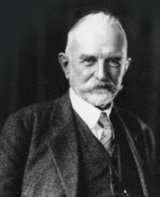George Mead
From Geography

George Herbert Mead (27. Februar 1863 - 26. April 1931) was an American philosopher and sociologist working at the University of Chicago. He worked closely alongside James H. Tufts and John Dewey, they were key figures in the pragmatist movement in Chicago. Throughout his whole life Mead never published a book so after his death in 1931 a group of his students read all his lecture notes and manuscripts and published a series of four books in his name.
George Mead is most well known for his work on symbolic interactionism. Symoblic interactionism is to do with how the human being develops in the process of social interaction, examples of social interaction could be language or play. The term social interaction was coined by Herbert Blumer one of Meads students at Chicago but it was based on Meads work. He also made significant contributions to the idea of behaviourism. One of his most well known contributions is the idea that behaviour is based on a pattern of stimulus and response. He distinguished between the act and the gesture. He describes the act as referring to the interactions with an object and the gesture refers to interactions with other people.In addition, Mead argues: that the social structures of roles and institutions affect individual behavior only through the common meanings expresses in the symbols of the group and the way in which these are interpreted in exchange between individuals(Campbell, 1981, p.215).
References
- Campbell, T. (1981). Seven Theories of Human Society. Clarendon Press, Oxford.
Contributers
Published by Laura Brunning
Enhanced by JensLubben 23:43, 16 December 2011 (CET)